VANCOUVER, BC / ACCESSWIRE / March 14, 2024 / HIGHLANDER SILVER CORP. (CSE:HSLV) (THE "COMPANY" OR "HIGHLANDER SILVER") is pleased to provide an update on the geological modelling work developed at La Estrella which will guide drill targeting in the upcoming drilling campaign.
During Q2 2023, Highlander Silver´s technical team developed a drill defined near surface exploration target of 15 to 35 Mt averaging between 50 and 60 g/t Ag, and 0.4 to 0.6 g/t Au containing some 25 to 60 Moz Ag and 0.2 to 0.7 Moz Au¹ (see news release of July 17th, 2023). In Q3 and Q4 2023, the team re-logged historic drill core and conducted geological mapping to develop an in-house geological model. The work focused on developing a comprehensive understanding of the controls on mineralisation to enable development of a prioritised set of targets for drill testing. The Company is now finalizing its drilling plan and is engaged in the drill permitting process. Highlander is targeting the end of Q2 2024 for mobilizing the drill rig.
¹ The potential quantity and grade of the exploration target is conceptual in nature, and more exploration is required to define a mineral resource. Important aspects such as metallurgical processing options need to be investigated to evaluate potential recoveries of Ag and Au. As such, it is uncertain if this work will result in the target being delineated as a mineral resource. In addition, further drilling will be required to investigate the extensions and continuity of the mineralization.
David Fincham, Highlander Silver´s President and CEO commented, "We continue to be impressed with the silver-gold potential at La Estrella. A large and strong alteration footprint, well mineralised historical drill intercepts and significant gaps in the historical drilling suggest excellent potential to improve on the numbers produced from our exploration target modelling. The technical team, led by Leandro Echavarria, has done an excellent job with the geologic model, resulting in a vastly improved understanding of the deposit and of the controls on mineralisation. Highlander Silver has developed the technical foundation to execute a drill program with the best chances of success".
Leandro Echavarria, the Company´s Vice President Exploration commented, "Our geologic model is based on the detailed drill core logging and surface mapping carried out by the technical staff at Highlander Silver. This model serves as the cornerstone for effective drill targeting to expand known mineralization zones. Identification of upflow channels that focused mineralised fluids allow us to target zones with potential for higher grade".
Regional Geology
The area is cut by a set of regional faults that control volcanism and emplacement of dome complexes (Fig. 1). Both the Julcani mine (105 million ounces of silver produced from high grade vein mineralisation averaging 16 ounces per ton since production started by Buenaventura in 1953) and the La Estrella deposit are emplaced along the fertile Julcani-Huancayo fault. La Estrella sits at an important inflection zone on the fault, generating a transtensional structural setting which enabled shallow dome emplacement, hydrothermal activity and Ag-Au ±Pb ±Zn ±Cu mineralisation.
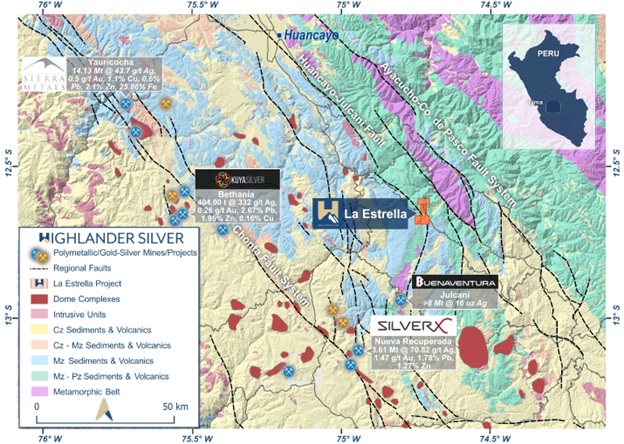
Fig. 1 La Estrella regional geology and structural setting
Local geology, hydrothermal alteration and mineralisation
Hydrothermal alteration and mineralisation at La Estrella are associated with a dome complex intruded along transtensional zones, exploiting the rheologic contrast between limestones and red beds (Fig. 2). The dome complex is more than 2 km long in the North to South direction and has a maximum width of 900 m, dipping about 35° West, and it is formed by numerous, irregular intrusion facies, where earlier basal facies are overlain by younger facies (Fig. 3).
The dome complex is cut by NE faults producing uplifted and down dropped blocks, with maximum measured displacements of about 80 m. These faults probably acted simultaneously with dome emplacement, acting as upflow channels of the hydrothermal fluids, and exert control on the alteration and mineralisation distribution.
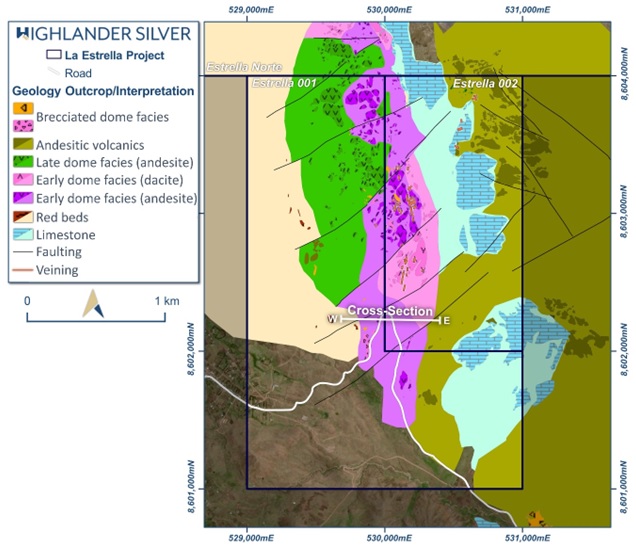
Fig. 2 Lithology map showing dome facies
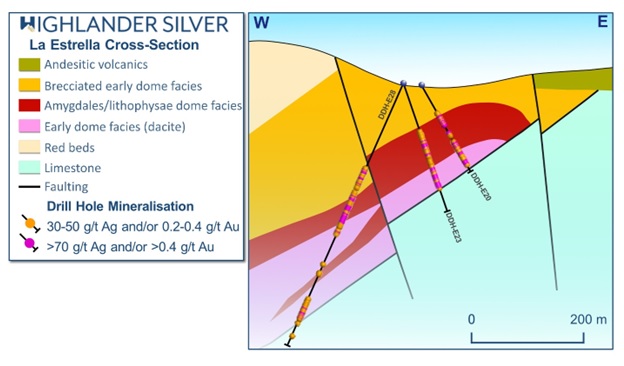
Fig. 3. Cross section showing dome facies and distribution of mineralisation. Note distribution of strongest mineralisation, hosted by the lower dome facies. Mineralised intercepts (not true widths) in hole DDH-E23 include: A) From 111.90 m to 122.5 m (interval 10.60 m) of 0.68 g/t Au and 12.43 g/t Ag. B) From 154.0 m to 163.3 m (interval 9.00 m) of 0.66 g/t Au and 138.58 g/t Ag. C) From 166.6 m to 197.2 m (interval 30.00 m) of 0.63 g/t Au and 7.94 g/t Ag.
Hydrothermal alteration is mostly hosted within the early facies of the dome complex, with a large silicified core surrounded by strong quartz-sericite alteration and an outer halo of weaker illite-kaolinite or chlorite alteration (Fig. 4). Hydrothermal alteration is pervasive affecting the vitreous-rich early dome facies, and follows upflow channels through a set of North-South and Northeast structures (Fig. 5).
The mineralisation is found in disseminated and vein forms, associated with silicification and quartz-sericite alteration.
There are 2 stages of mineralisation: 1. Early stage and 2. Epithermal stage (Fig. 6).
1. Early stage: Related to a late-stage magmatic derived, high temperature hydrothermal fluid, introduced into the dome complex shortly after emplacement, forming a large footprint of ~2,000 m x 600 m controlled by NE and N-S structures. Mineralisation of Au±Cu±As is associated with medium-coarse pyrite, within veinlets, disseminated, cementing hydrothermal breccias or as quartz vein halos.
2. Epithermal stage: Later than the Early stage, consists mainly of quartz with fine-grained dark sulphides (pyrite-Ag sulphosalts and scarce galena and chalcopyrite) with polymetallic mineralisation of Ag±Au-Pb>Cu>Zn. The epithermal stage is commonly emplaced in discontinuous and thin structures, and as diffuse halos around early stage pyrite, mainly related to NE upflow structures.
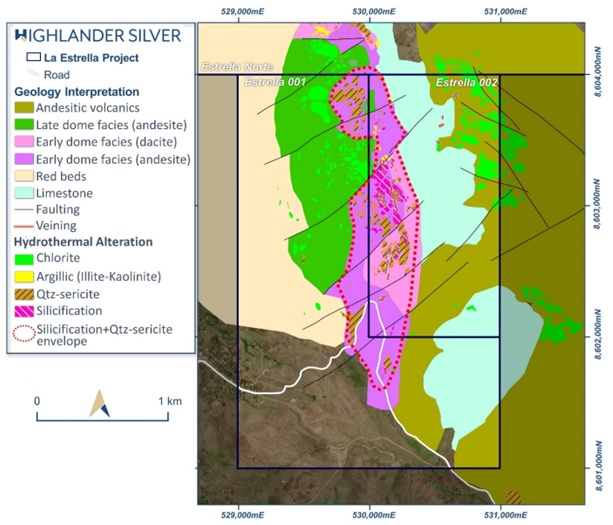
Fig. 4. Map showing the widespread distribution of hydrothermal alteration, which forms a large zone of about 2,000 m x 500 m with a silicified core surrounded by quartz-sericite alteration.
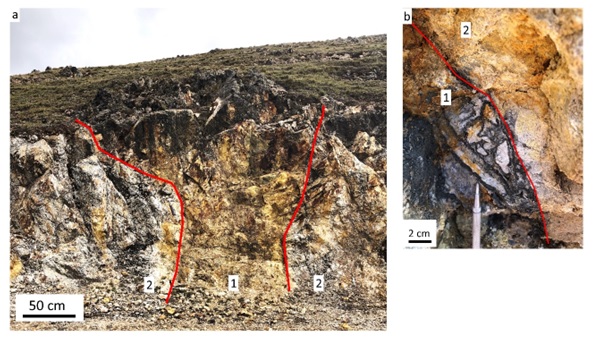
Fig. 5. a. Silicified (quartz+pyrite) and mineralised ridge (1) with halos of quartz-sericite alteration (2), which is part of a large set of prospective Northeast structures at the central block of the dome complex. b. Detailed of upflow channel formed by hydrothermal breccia cemented by fine-grained black sulphides and quartz (1) hosted by early dome facies with quartz-sericite alteration (2).
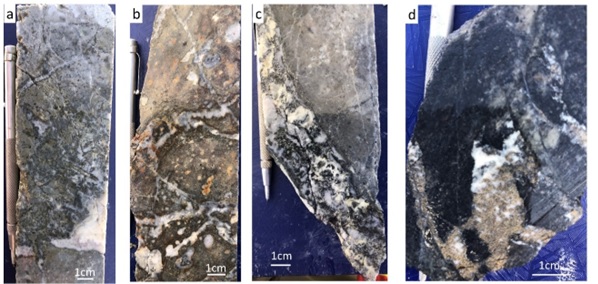
Fig. 6. Core photos from Early stage and Epithermal stage mineralisation.
1. Early stage mineralisation:
a. Fine-grained porphyritic dacite with veinlets, irregular open space filling and disseminations. DDH-E26: 177 m, 2.49 g/t Au, 13 g/t Ag.
b. Amygdale - rich andesite, mineralisation in irregular quartz veinlets and amygdale filling with pyritic halos. DDH-E24: 128 m, 0.79 g/t Au, 4 g/t Ag.
2. Epithermal stage mineralisation:
c. Quartz+fine-grained sulphides veinlet. DDH-E24: 244 m, 0.25 g/t Au, 97 g/t Ag.
d. Structurally controlled hydrothermal breccia cemented by quartz+sulphides. DDH-E12, 182.5-183.5 m. 0.75 g/t Au, 216 g/t Ag, 7.06% Pb, 2.72% Zn.
The understanding gained from development of the 3D geologic model enables targeting of the most prospective areas for economic mineralisation. The upcoming drill program will have two main objectives: a) expand the zone of known Ag-Au mineralsation and b) target structurally favourable zones for high grade feeder potential.
The Company looks forward to providing further updates over the coming weeks.
Qualified Person
All scientific and technical information contained in this news release was prepared and approved by Walter La Torre, (Qualified Person), MAusIMM (CP). Mr. La Torre has verified the scientific and technical information disclosed in this news release by reviewing the sampling, analytical and drilling data from the Property.
About Highlander Silver
Highlander Silver Corp., backed by the Augusta Group and the Lundin Family, is a mineral exploration company focused on the discovery of exceptional silver-gold projects in the Central Andes, leveraging the team's significant technical and operational experience in Peru and South America more widely. Currently the Company is developing the La Estrella project in central Peru. Highlander Silver announced entering into a share purchase agreement for the San Luis project from SSR on November 30th 2023. Closing of the Transaction is subject to certain conditions, including receipt of all required regulatory approvals. Closing is currently expected to occur in April 2024.
The Company is listed on the CSE under the ticker symbol HSLV and additional information about Highlander Silver and its mineral projects can be viewed on the Company's SEDAR+ profile at (www.sedarplus.ca) and its website at www.highlandersilver.com
Neither the Canadian Securities Exchange (CSE) nor the Investment Industry Regulatory Organization of Canada (IIROC) accepts responsibility for the adequacy or accuracy of this news release.
For further information, please contact:
David Fincham
Chief Executive Officer
Highlander Silver Corp.
(604) 283 7630
info@highlandersilver.com
Forward-Looking Information
Certain information contained in this news release constitutes "forward-looking information" under Canadian securities legislation. This includes, but is not limited to, information or statements with respect to the future exploration plans of the Company, permitting and timing of future exploration, timing for the Company's mobilization of the drill rig, and the acquisition of the San Luis silver-gold project, which has not yet closed.. Such forward-looking information or statements can be identified by the use of words such as "anticipates", "plans", "suggests", "targets" or "prospects" or variations (including negative variations) of such words and phrases, or state that certain actions, events or results "will" be taken, occur, or be achieved. Forward-looking information involves known and unknown risks, uncertainties, and other factors which may cause the actual results, performance, or achievements of the Company and/or its subsidiaries to be materially different from any future results, performance, or achievements expressed or implied by the forward-looking information. Such factors include, among others, general business, economic, competitive, political and social uncertainties, the actual results of current exploration activities, changes in project parameters as plans continue to be refined, accident, labour disputes and other risks of the mining industry, and delays in obtaining governmental approvals or financing. Although the Company has attempted to identify important factors that could cause actual actions, events or results to differ materially from those described in forward-looking information, there may be other factors that could cause actions, events or results to differ from those anticipated, estimated or intended. Forward-looking information contained herein are made as of the date of this news release. There can be no assurance that forward-looking information will prove to be accurate, as actual results and future events could differ materially from those anticipated in such statements. The Company undertakes no obligation to update forward-looking information if circumstances or management's estimates or opinions should change, except as required by applicable securities laws. Accordingly, the reader is cautioned not to place undue reliance on forward-looking information.
SOURCE: Highlander Silver Corp.
View the original press release on accesswire.com

